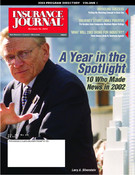History will always view 2001 by what happened in 100 minutes, changing how we as a society view security and how we as an industry view risk.
The year 2002 will be judged by what didn’t happen. The industry responded effectively in the aftermath of Sept. 11, a loss of historic dimensions that will approach $40 billion. Confronted by a first-ever industry-wide loss, insurers strengthened underwriting and increased premium, putting the industry back on positive financial ground while coping with an economy in recession, decreased investment income and the potential liability from the evaporation of trillions in market value and shareholder equity.
Gazing through a crystal ball that is at best partly cloudy, what challenges will 2003 bring? Three issues are likely to dominate the insurance agenda.
Terrorism
The war on terrorism is far from over and the risk of further attacks is real. The market for terrorism contracted significantly following Sept. 11 and will again if there are further events.
Congress spent the year debating and finally passing legislation that provides a federal backstop for terrorism insurance. The bill brings much needed capacity back to the market at a critical time, closing the supply and demand gap that principally affected large businesses with high profile structures and major concentrations of people in one place. Individual insurers will be in a better position to make decisions about the nature and amount of risk they want to insure, though nothing will reestablish the status quo that existed before Sept. 11. This is particularly true of reinsurers, who, because of the triple whammy of terrorism, asbestos and market losses, are in no position at this stage to assume the same amount of terrorism risk they previously shouldered.
The cost of terrorism coverage will depend on many factors over time, most significantly progress with the war on terrorism. Policymakers will be watching carefully to see how the market responds.
Home and auto
Regulators and many consumers do understand the need, after a decade of competitive prices, to tighten underwriting and raise premiums in the face of higher losses, lower investment returns and new dangers such as mold. Insurers believe that the current hard market needs to continue for at least one and possibly two years before the bottom line of most companies is sufficiently repaired. The public is not likely to want to give the industry that much time. In fact, there are already loud protests that the industry has gone too far, both in terms of pricing and business practices.
The road in 2003 will become bumpier as regulators deal with the consequences of increased rates and tighter underwriting. As insurers announce a return to profitability in 2003, there will be increased pressure, just like the tax cut fever in Washington, to give consumers back some of their money.
There will be greater public anxiety over the availability of coverage and the consequences of using the insurance product. This potential backlash will be manifest in the ongoing public debate over the use of credit information in underwriting. The public may well allow the government and law enforcement greater latitude on privacy to fight the war on terrorism, while drawing a line at the private sector.
Tort reform
At the heart of many major issues confronting the industry is the question of tort costs, the most compelling being asbestos. Public policy experts thought the asbestos problem was solved decades earlier. Now, the RAND Institute for Civil Justice estimates that we are less than halfway through the global claim cycle. This continues to have a profound effect on the adequacy of reserves. 2003 may bring movement towards the first revision of the asbestos tort system in some time.
Regarding medical malpractice, the one-two punch of rising medical and legal costs has produced localized crises across the country, creating dangerous gaps in the availability of quality health care for average Americans. Despite protests by the trial bar, governors and state legislatures will continue to study, and in many cases pass, caps on non-economic damages modeled after California’s MICRA law.
There is not likely to be a push in Washington for broad tort reform, but it is possible that progress can be made on a case-by-case basis, addressing how specific tort practices affect individual insurance lines with unintended consequences and high costs for the economy and society at large.
Philip J. (P.J.) Crowley is vice president of Public Affairs at the Insurance Information Institute (III) in New York. In this capacity, he is a national spokesman for the property and casualty industry.
Topics Catastrophe
Was this article valuable?
Here are more articles you may enjoy.


 Microsoft Tells Texas Agencies They Were Exposed in Russian Hack
Microsoft Tells Texas Agencies They Were Exposed in Russian Hack  Zurich to Buy AIG’s Travel Insurance Business for $600 Million
Zurich to Buy AIG’s Travel Insurance Business for $600 Million  Farmers Adjusters Cry Foul Over Workloads, Claims Handling in Letter to Regulators
Farmers Adjusters Cry Foul Over Workloads, Claims Handling in Letter to Regulators  ‘Great Resignation’ Enters Third Year as Workers Embrace AI, Upskilling, PwC Says
‘Great Resignation’ Enters Third Year as Workers Embrace AI, Upskilling, PwC Says 


